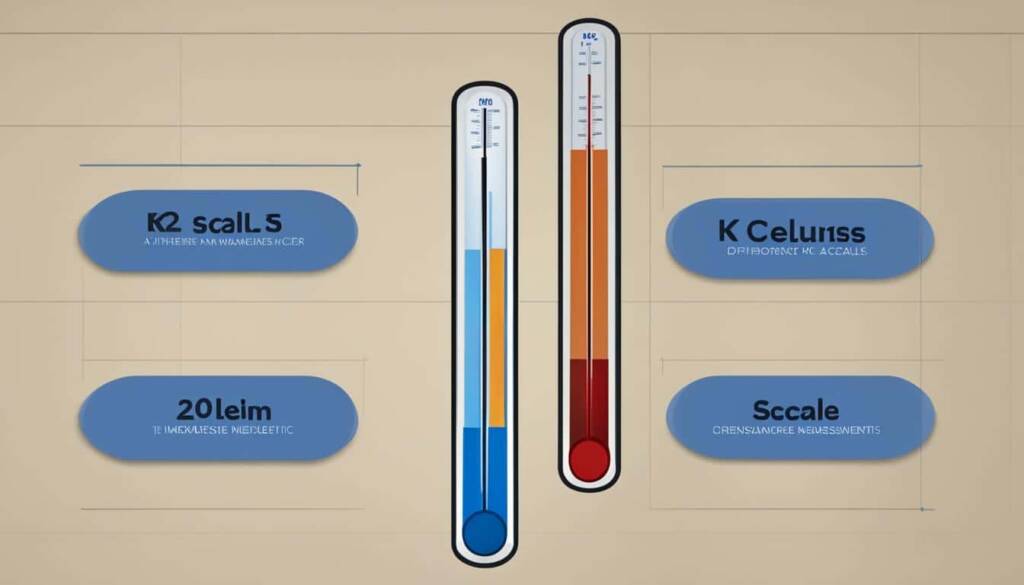Table of Contents
The kelvin, symbol K, is the unit of measurement for temperature in the International System of Units (SI). It is an absolute scale, meaning it starts at absolute zero, which is 0 K. A change of 1 K corresponds to a change of thermal energy kT by 1.380649×10−23 J. The Kelvin scale was developed from the Celsius scale, with 273.15 K being equivalent to 0 °C. The Kelvin scale is widely used in the physical sciences, while the Celsius scale is more common in everyday life. The kelvin is named after physicist William Thomson, 1st Baron Kelvin.
The Kelvin Scale and its Conversion
The Kelvin scale is the primary unit of temperature for engineering and the physical sciences. It is used alongside its prefixed forms, such as millikelvin (mK) and microkelvin (µK).
To convert a temperature in kelvin to Celsius, subtract 273.15. To convert a temperature in Celsius to kelvin, add 273.15. To convert a temperature in kelvin to Fahrenheit, use the formula (1.8x – 459.67), where x is the temperature in kelvin. To convert a temperature in Fahrenheit to kelvin, use the formula ((x + 459.67)/1.8), where x is the temperature in Fahrenheit.
Conversion Formulas
| Kelvin to Celsius | Celsius to Kelvin | Kelvin to Fahrenheit | Fahrenheit to Kelvin |
|---|---|---|---|
| K – 273.15 | C + 273.15 | 1.8K – 459.67 | (F + 459.67)/1.8 |
These conversion formulas allow for easy coordination between the Kelvin, Celsius, and Fahrenheit temperature scales, enabling accurate measurements and comparisons.
The Re-Definition of Kelvin
The kelvin, a unit of measurement for temperature in the International System of Units (SI), underwent a significant re-definition in 2019 as part of the overall redefinition of SI base units. This new definition of the kelvin is based on the Boltzmann constant, a fundamental physical constant that relates thermodynamic energy to temperature. The Boltzmann constant, now exactly 1.380649 × 10-23 J/K, forms the foundation for the precise and accurate measurement of temperature.
By aligning the kelvin with the Boltzmann constant, the re-definition ensures a direct link to a universally recognized constant. This enhances the accuracy and reliability of temperature measurements. The new definition not only provides a more rigorous and consistently measurable unit, but it also opens doors for advancements in thermodynamics and scientific research.
The implications of this re-definition are far-reaching. Researchers and scientists can rely on the new paradigm to better understand temperature effects and behaviors across various scientific fields. Additionally, the precise measurement of temperature using the Boltzmann constant as the basis for the kelvin contributes to the refinement and advancement of thermodynamic theories and models.
FAQ
What is the kelvin in temperature measurement?
The kelvin, symbol K, is the unit of measurement for temperature in the International System of Units (SI). It is an absolute scale that starts at absolute zero, which is 0 K. A change of 1 K corresponds to a change of thermal energy kT by 1.380649×10−23 J.
How does the Kelvin scale relate to the Celsius scale?
The Kelvin scale was developed from the Celsius scale. 273.15 K is equivalent to 0 °C. The Kelvin scale is widely used in the physical sciences, while the Celsius scale is more common in everyday life.
What are the prefixed forms of the kelvin used in temperature measurement?
The kelvin is used alongside its prefixed forms, such as millikelvin (mK) and microkelvin (µK), in temperature measurement for engineering and the physical sciences.
How do I convert temperature in kelvin to Celsius?
To convert a temperature in kelvin to Celsius, subtract 273.15 from the kelvin value.
How do I convert temperature in Celsius to kelvin?
To convert a temperature in Celsius to kelvin, add 273.15 to the Celsius value.
How do I convert temperature in kelvin to Fahrenheit?
To convert a temperature in kelvin to Fahrenheit, use the formula (1.8x – 459.67), where x is the temperature in kelvin.
How do I convert temperature in Fahrenheit to kelvin?
To convert a temperature in Fahrenheit to kelvin, use the formula ((x + 459.67)/1.8), where x is the temperature in Fahrenheit.
What was the re-definition of the Kelvin in 2019?
The kelvin was re-defined in 2019 as part of the redefinition of the SI base units. The new definition is based on the Boltzmann constant, which relates thermodynamic energy to temperature. The Boltzmann constant is now exactly 1.380649 × 10-23 J/K.
What are the implications of the new definition of the Kelvin?
The new definition provides a more precise and accurate measurement of temperature and ensures that the kelvin is directly linked to fundamental physical constants. It has important implications for the field of temperature measurement and provides a solid foundation for future advancements in thermodynamics and scientific research.












